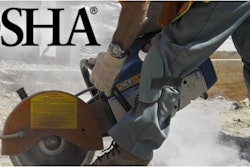Think back to a time not so long ago when workers would pull apart an old building, throwing asbestos-filled materials into piles and scattering particles everywhere — all without any safety equipment in sight to prevent inhalation of the floating dust and debris. Regulations soon changed that. They now clearly define proper handling procedures for asbestos-containing materials and requirements for PPE to protect workers against exposure. Restrictions are also in place severely limiting the application of this material.
We have yet to reach the same degree of regulation when it comes to exposure to crystalline silica, another common, and potentially deadly, jobsite hazard. Silica is a known carcinogen, and is known to cause silicosis, a restrictive lung disease. Airborne silica dust is a byproduct of cutting, sawing, drilling and crushing of concrete, brick, block and other stone products.
Yet, as we saw with asbestos, times are changing. In our October 2013 issue, we reported on a proposed rule from OSHA that would further restrict permissible exposure limits to airborne silica and prescribe control measures (“Proposed Silica Rule Causes Concern”, ForConstructionPros.com/11148931). While it seeks to update the 40-year-old limits currently in place, the proposal has generated a number of questions on what dust control measures may be required in future on construction sites.
“With the Occupational Safety and Health Administration’s recent announcement of a proposed standard to better protect construction workers and others from silica dust, contractors are increasingly asking questions about the hazard; the materials and tasks that pose a danger; and the availability of controls to protect workers from exposure,” states Eileen Betit, Director of Special Projects for CPWR – The Center for Construction Research and Training, a nonprofit construction safety and health research institute supported by the National Institute for Occupational Safety and Health (NIOSH).
To address these questions, the CPWR has developed Work Safely with Silica (www.silica-safe.org), a one-stop online resource to help contractors work through these issues. The site contains the latest on regulatory efforts, news articles, examples of what other contractors are doing and related scientific research, including the results of almost two decades of CPWR research on the silica hazard and controls.
The site also features an online planning tool called Create-a-Plan, which is designed to help contractors assess the hazard on a particular job, find the tools and equipment to control the hazard and generate a site-specific silica control plan. Create-a-Plan includes lists of building materials that contain silica and construction tasks that generate dust; a list of commercially available equipment and control options; and space to document elements of a comprehensive silica control plan. You can find out more in the article “New Site Provides Three Steps to Working Safely with Silica” at ForConstructionPros.com/11249327.
Taking steps to mitigate the hazards on your projects should be a no-brainer, but unfortunately, not all construction firms do so, or do enough. In some cases, it’s a matter of not knowing where to start. Work Safely with Silica is a step in the right direction, making the process easier and more accessible to contractors of all types and sizes.
Be sure to check out the information and tools on the site, then use it to start building your concrete-related shopping list for World of Concrete, which will be held in Las Vegas this month. You can find additional equipment to add to that list starting on page ??.




















